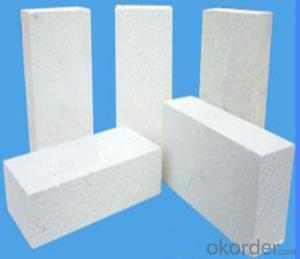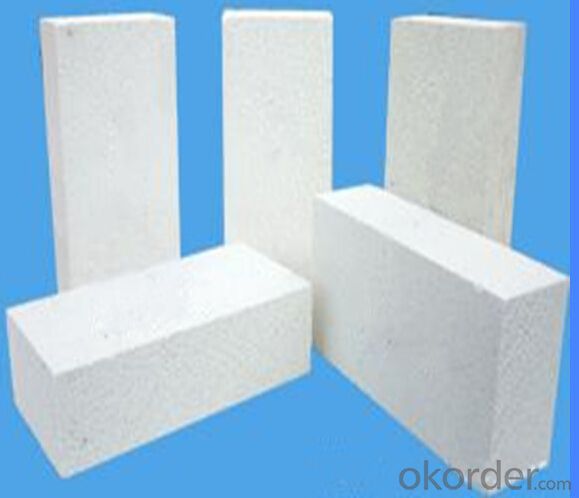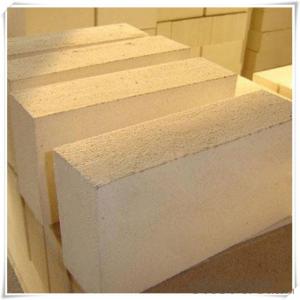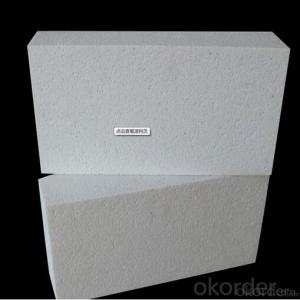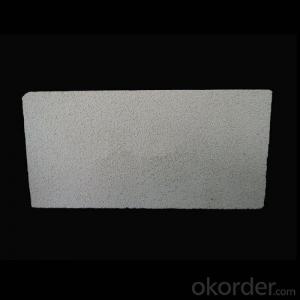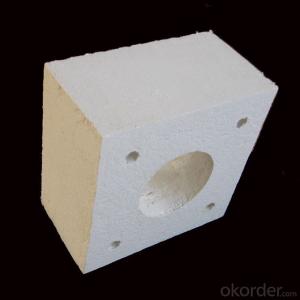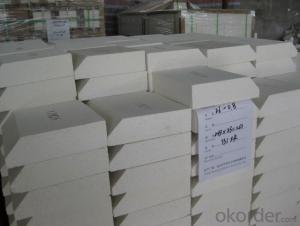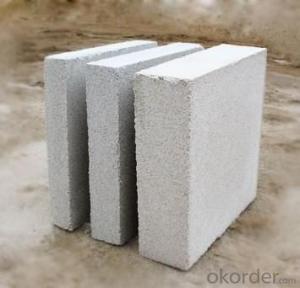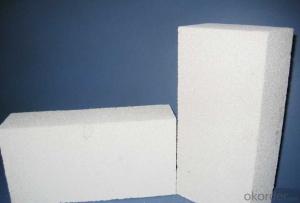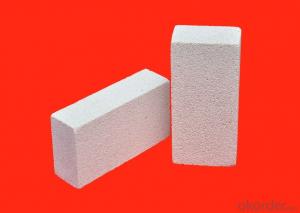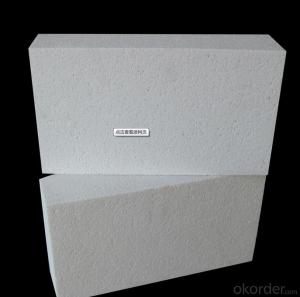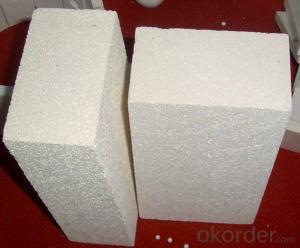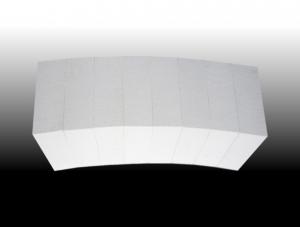Insulating Fire Brick - Refractory GJM Mullite Insulation Brick B-2
- Loading Port:
- Shanghai
- Payment Terms:
- TT OR LC
- Min Order Qty:
- 10 m.t.
- Supply Capability:
- 1000 m.t./month
OKorder Service Pledge
OKorder Financial Service
You Might Also Like
Specifications
mullite insulation brick
1. Low thermal conductivity
2.High hot compressive strength
3.Perfect Energy saving
Light weight mullite insulation furnace bricks refractory for sale
Advantage
1. Low thermal conductivity
2.High hot compressive strength
3.Perfect Energy saving
Description:
Lightweight mullite kiln bricks refractory for sale are made from good quality and superpure raw materials, with strictly classified fillings according to their grades. These fillings can form a uniform pore structure after burnt during the process of manufacture. Each grade of products has unique design to meet different thermal, physical and chomical demands.
Application:
Mullite insulation furnace bricks refractory material can be used in linings or heat-insulating materials of the industries, such as, ethylene pyrolysis furnaces, tubular furnaces, reforming furnaces of synthetic ammonia, gas generators and high-temperature shullte kilns, etc
Mullite Insulation furnace refractory material can be used as working lining, where contact with flames directly. This kind of brick can save the kiln energy very much
- Q: Are insulating fire bricks resistant to chemical attack?
- Yes, insulating fire bricks are generally resistant to chemical attack. These bricks are made from high-purity refractory materials, such as alumina or silica, which have excellent chemical stability. They are designed to withstand high temperatures and are thus highly resistant to the corrosive effects of chemicals. However, it is important to note that the degree of chemical resistance can vary depending on the specific composition of the insulating fire brick and the type of chemical being used. In some cases, certain aggressive chemicals may still cause some degree of degradation or erosion over time. Therefore, it is always recommended to consult the manufacturer or supplier for specific information regarding the chemical resistance of insulating fire bricks in relation to the intended application.
- Q: Can insulating fire bricks be used in the construction of ceramic tile kilns?
- Yes, insulating fire bricks can be used in the construction of ceramic tile kilns. Insulating fire bricks are specifically designed to withstand high temperatures and provide excellent insulation properties. They have low thermal conductivity, which means they help to retain heat within the kiln and prevent it from escaping, resulting in more efficient and effective firing of ceramic tiles. Additionally, their lightweight nature makes them easy to handle and install in the kiln structure. Overall, using insulating fire bricks in the construction of ceramic tile kilns can help improve energy efficiency, reduce heat loss, and ensure consistent and controlled firing temperatures.
- Q: Do insulating fire bricks have a high fire resistance rating?
- Insulating fire bricks possess an impressive fire resistance rating. These bricks are specifically crafted to endure elevated temperatures while providing exceptional insulation against heat transfer. They are composed of high-purity refractory materials, namely alumina and silica, which possess a high melting point and can withstand extreme heat. With the ability to endure temperatures reaching 3000°F (1650°C), insulating fire bricks exhibit significantly lower thermal conductivity compared to ordinary bricks or alternative materials. This renders them highly suitable for applications necessitating strong fire resistance, such as industrial furnaces, kilns, fireplaces, and chimneys. Moreover, their insulating properties aid in reducing heat loss, thereby promoting energy efficiency and cost-effectiveness.
- Q: Can insulating fire bricks be used in the construction of glassware molds?
- Yes, insulating fire bricks can be used in the construction of glassware molds. Insulating fire bricks are made of lightweight materials that have excellent insulation properties, making them suitable for use in high-temperature applications such as glassware molds. These bricks can withstand the extreme heat generated during the glass molding process and help maintain a consistent temperature within the mold. Additionally, insulating fire bricks have low thermal conductivity, which prevents excessive heat loss and ensures efficient energy usage. Overall, using insulating fire bricks in the construction of glassware molds can provide better heat retention, improved thermal efficiency, and enhanced mold stability, resulting in higher quality glass products.
- Q: Can insulating fire bricks be used for chimney lining?
- Yes, insulating fire bricks can be used for chimney lining. Insulating fire bricks are designed to withstand high temperatures and are excellent for insulating chimneys, providing thermal protection and enhancing energy efficiency.
- Q: Can insulating fire bricks be used in the construction of brick kilns?
- Yes, insulating fire bricks can be used in the construction of brick kilns. Insulating fire bricks are specifically designed to have high thermal resistance, which makes them ideal for applications where insulation is required. In brick kilns, insulating fire bricks can be used to line the walls, floor, and roof of the kiln, helping to retain heat and improve energy efficiency. These bricks are capable of withstanding high temperatures and can provide insulation against the heat generated during the firing process. Additionally, insulating fire bricks can also help reduce heat loss, resulting in faster and more efficient firing cycles. Overall, using insulating fire bricks in the construction of brick kilns can enhance their performance and contribute to more effective and sustainable kiln operation.
- Q: Are insulating fire bricks suitable for use in glass furnaces?
- Yes, insulating fire bricks are indeed suitable for use in glass furnaces. These fire bricks are specifically designed to withstand high temperatures and provide excellent thermal insulation. They help to maintain consistent heat levels within the furnace, prevent heat loss, and reduce energy consumption. Additionally, insulating fire bricks are resistant to chemical reactions and can withstand the corrosive environment of a glass furnace.
- Q: What are the different sizes and shapes available for insulating fire bricks?
- Insulating fire bricks are offered in a variety of sizes and shapes to accommodate different applications and requirements. The size options for insulating fire bricks typically span from standard measurements like 9" x 4.5" x 2.5" (commonly referred to as "9-inch bricks") to smaller dimensions such as 9" x 4.5" x 1". These standard sizes are extensively utilized in the construction of fireplaces, kilns, furnaces, and other applications involving high temperatures. In addition to the standard sizes, manufacturers also provide insulating fire bricks in custom sizes, allowing for greater design and construction flexibility. The custom sizes may vary depending on the manufacturer, but they generally adhere to the same width and length measurements as the standard bricks. Regarding their shape, insulating fire bricks are typically rectangular or square. The rectangular shape is the most prevalent and versatile, enabling easy installation and arrangement in various structures. Although square-shaped bricks are also available, they may be less commonly utilized. It is important to note that insulating fire bricks can be further classified based on their density or insulation value. These bricks are typically categorized into three groups: low-density, medium-density, and high-density. Each category possesses distinct insulating properties, with low-density bricks offering the highest insulation value. In summary, the extensive range of sizes and shapes offered for insulating fire bricks allows for customization and adaptability to different construction projects, ensuring optimal insulation and heat retention in applications involving high temperatures.
- Q: Do insulating fire bricks require any special tools for installation?
- Special tools are necessary for installing insulating fire bricks. Some examples of common tools that may be required are a trowel, masonry hammer, chisel, masonry saw, and a masonry drill with the appropriate bits. These tools are essential for cutting the bricks to the desired shape and size and for creating openings or channels for flues, vents, or other components. Additionally, a mortar mix that can withstand high temperatures is needed to securely hold the bricks in place. To ensure a proper and safe installation, it is crucial to carefully follow the manufacturer's instructions and use the recommended tools.
- Q: Can insulating fire bricks be used for pizza ovens?
- Indeed, pizza ovens can make use of insulating fire bricks. These bricks have been specifically crafted to endure extreme heat and offer exceptional insulation, positioning them as an optimal selection for pizza ovens. By possessing low thermal conductivity, insulating fire bricks excel at retaining heat for extended durations, guaranteeing that your pizza is evenly and efficiently cooked. Moreover, their lightweight composition allows for effortless handling and installation in a pizza oven. Ultimately, the utilization of insulating fire bricks within a pizza oven can effectively uphold high temperatures, diminish heat loss, and enhance the overall cooking proficiency.
Send your message to us
Insulating Fire Brick - Refractory GJM Mullite Insulation Brick B-2
- Loading Port:
- Shanghai
- Payment Terms:
- TT OR LC
- Min Order Qty:
- 10 m.t.
- Supply Capability:
- 1000 m.t./month
OKorder Service Pledge
OKorder Financial Service
Similar products
Hot products
Hot Searches
Related keywords
